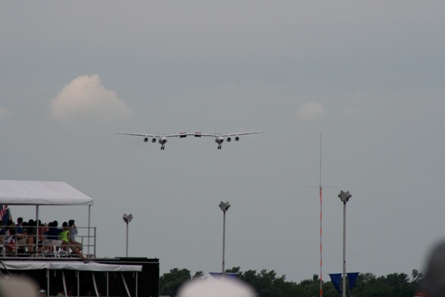Virgin Galactic pulled off a coup at Oshkosh, flying WhiteKnight Two for the first time in public on 28 July, the day it signed a $280 million deal with an Abu Dhabi investor that will see Sir Richard Branson's venture move into the satellite launch sector.
The arrangement gives Aabar Investments - ultimately owned by Sheikh Mansour bin Zayed al-Nahyan - a 32% stake in the space tourism company and opens the door for the development of a spaceport in the Gulf emirate, the second after the first base in New Mexico.
|
|---|
Above: Virgin Galactic's WhiteKnight Two flies at the EAA Airventure Oshkosh air show in July 2009 |
Virgin Galactic will use the cash injection to develop equipment - including a new pylon between the twin hulls of WhiteKnight Two - able to carry a two-stage launcher and satellite weighing up to 200kg (440lb), with a total payload of 17t- into orbit. The aircraft is designed as the mothership for Virgin Galactic's spaceliner SpaceShip Two.
Virgin Galactic's chief executive Will Whitehorn says that the company will begin its space cargo business in about three years time, two years after it expects to carry the first paying space tourists into suborbit. "For the first five or six years, 80% of our business will be tourism, but five to nine years after that it will be 50/50 [between passengers and cargo or training and scientific flights]," he says.
The history of LauncherOne Named LauncherOne by Virgin Galactic president Will Whitehorn in December 2008, the spaceline has been talking about a satellite launcher for years. Surrey Satellite Technology completed a feasibility study for a micro satellite launcher and provided it to the UK government last year. The concept rocket is a two-stage all-composite vehicle that could launch 200kg (440lb) into low Earth orbit. The UK government is prepared to fully support its development and Surrey Satellite has submitted a request for support for a phase A study that could start this year. However, the company would not develop the rocket - a third party is sought to do that. |
Whitehorn says the company could take the cost of launching a satellite into space using a ground-based launcher from $30 million to "as low as $2 million" using WhiteKnight Two.
He expects the first satellite launchers to be Virgin's own design, either built at its factory in Mojave, California or contracted out to a specialist manufacturer, but eventually the aircraft will be able to carry third-party boosters.
Whitehorn says that Virgin Galactic was approached by Aabar because the latter saw the opportunity beyond space tourism for the Scaled Composites-built WhiteKnight Two.
"This investment now gives us the capital to take us through the commercial launch and build an extra WhiteKnight for the satellite business," he says.
Virgin Galactic says it expects to fly SpaceShip Two on WhiteKnight Two from New Mexico in December.
As with the facility in New Mexico, which is owned by the state, Virgin Galactic does not expect to invest in the Abu Dhabi spaceport.
"We will enter into a leasing agreement," says Whitehorn.
Further spaceports are mooted for the north of Scotland and Scandinavia, where there is expected to be demand for flights to view phenomena such as the Northern Lights.
Branson joined Scaled Composites test pilots Peter Siebold and Clint Nichols for the flight at Oshkosh. The vehicle, which remained on static display, drew huge crowds all week.
Source: Flight International























